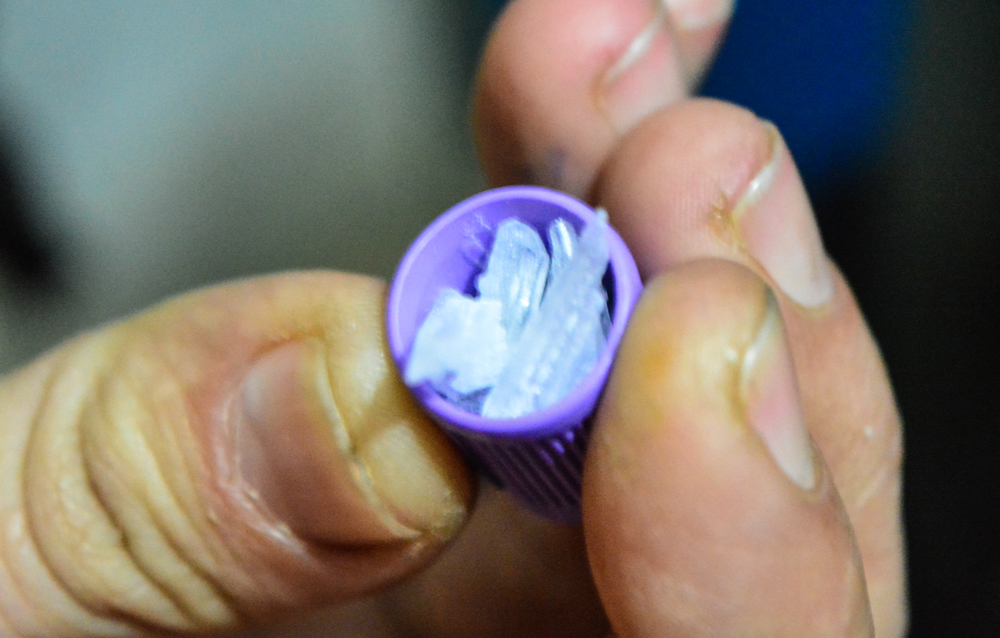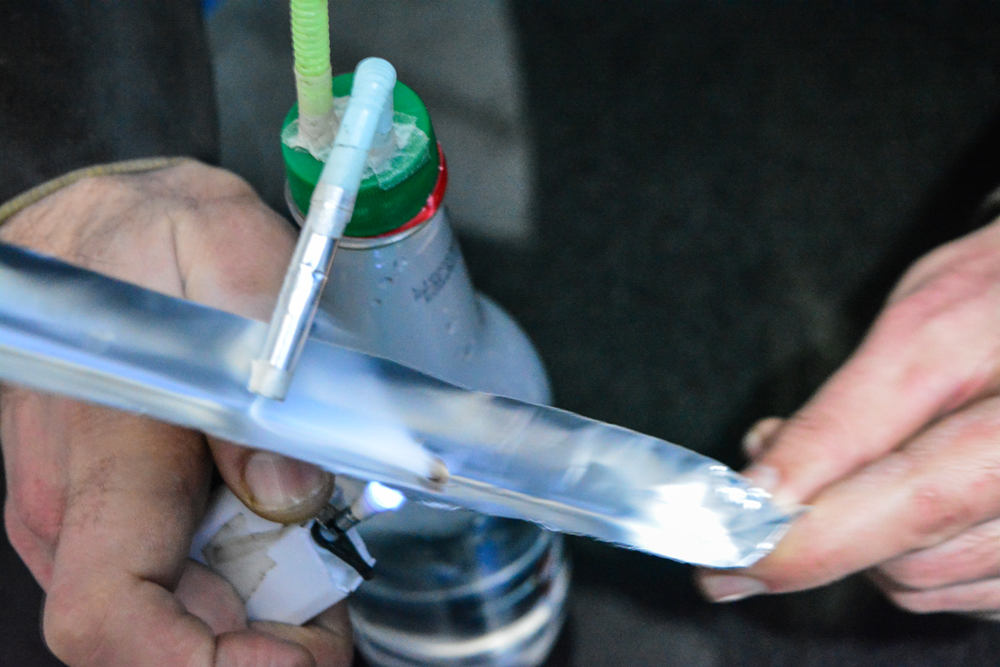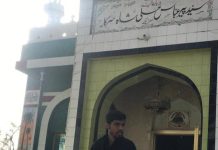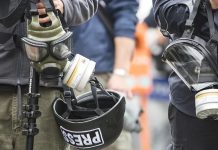Peshawar: Wild eyed and hollow-cheeked, there are seven pale men in the room. Subterranean in its gloom, the room holds them together like septuplets in a womb, warm and comforting, its air redolent with the staleness of their breath, the chemical smell of their sweat. They sit close to each other, surfacing to reality, to the here and now, with some effort when addressed. But they can’t stay on the surface for long, always wanting to plunge back again.
Some here are students. One is a mechanic, another a daily-wage labourer. One of them is “self-employed” but reluctant to share more about his vocation. From their speech, struggles and stories, you can tell all of them belong to the middle-class.
“I didn’t sleep for five days when I first tried it,” said Ahmad Khan, 30, sitting in a corner, speaking of the sense of the energy and hyperactivity that crystal methamphetamine, a stimulant “club-drug”, imparts to its users. ““It makes me enjoy life even without sleeping.”
But this gathering in a room in Peshawar is hardly a party – and if it is than the fun never stops for the people in the room who converge here daily to inhale “ice”.
Of late, lawmakers and law enforcing agencies in Khyber Pakhtunkhwa have been in a fix, cracking down on drug-paddlers promoting crystal methamphetamine or ice, as it is locally known, but not knowing how to deal with them legally because there is no provision in the law on how to deal with a drug they call “new form of heroin.”
“The ice available in Peshawar is a synthetic chemical,” says Dr. Mian Mukhtar ul Haq Azeem, Assistant Professor of Psychiatry at the Lady Reading Hospital in Peshawar. “It is manmade, unlike cocaine or hashish, for instance, which comes from a plant,” he told News Lens Pakistan.
The province’s top cop, Inspector General of KP Police Nasir Durrani, said the police would take action against dealers and users of meth after “reviewing the legal position of the drug and then cracking down on them across the province.”
The ice available in Peshawar comes for different prices. Locally manufactured, it is more expansive than heroin and hashish. Mohammad Ali who is addicted to ice told News Lens Pakistan he has been buying it for Rs. 1500 to Rs. 3000 per gram in the local market.

Crystal or meth – short for methamphetamine – is made from ephedrine through a chemical process. It induces long term exuberance and hyperactivity that according to medical experts, exact a heavy price by damaging those addicted to it both physically and psychologically.
Of the seven men in the room, one is Janan Khan, 35. His gaunt looks speak of Janan’s addiction to meth, a dependency he says he cannot shake. “Once I tasted ice, I was immediately hooked,” he mutters, adding that he has lost his parents, wife, two children, friends, wealth and even his profession to the habit.
The lanky Khan, a resident of the Ghanj neighbourhood in the old city, was something of a master at baking cakes, he says. He worked in a bakery before his addiction to meth made him give up the job. “I used to earn a handsome amount,” says Khan, who now takes one gram of ice daily, spending more than Rs. 20,000 rupees to secure his monthly supply of meth. “In the beginning, I only took a few puffs for fun with some friends but it destroyed my life. My family abandoned me and my wife left along with the children due to my aggressiveness and addiction.”
Khan says he sold his wife’s jewelry, worth Rs. 80,000, to secure meth. “I have tried to get rid of the habit and given up in the past but I start all over again after a week.”
According to the National Institute of Drug Abuse fact-sheet on methamphetamine, “Long-term methamphetamine use has many negative consequences for physical health, including extreme weight loss, severe dental problems (“meth mouth”), and skin sores caused by scratching. Methamphetamine use also raises the risk of contracting infectious diseases like HIV and hepatitis B and C. These can be contracted both by sharing contaminated drug injection equipment and through unsafe sex. Regardless of how it is taken, methamphetamine alters judgment and inhibition and can lead people to engage in these and other types of risky behavior. “
In Peshawar, most dealers of crystal or ice are based in the Khyber Agency where heroin and hash is also produced, largely consumed locally but also smuggled abroad, according to Khan. “They control most of the production and distribution of ice in Peshawar. Most of the addicts from Peshawar, Mardan, Nowshera and Charsadda go to Khyber Agency to to get their fix.”
In 2014, Hanif Abbasi, a former member of the National Assembly belonging to the ruling Pakistan Muslim League (Nawaz) party, was indicted in a court case for “appropriating and selling” 500 kg of ephedrine to narcotics smugglers in 2010.”
Here in the room is a driver who works for a government employee and doesn’t want to be named. He says he has used ice for the last four years. “Once I took meth worth Rs. 0.3 million in a month. I stayed in a room for a month.”
Ijaz Afridi, a 25 year-old resident of Khyber Agency who came to rehabilitation centre at the Lady Reading Hospital to quit the drug habit, said he had spent 12 days at the hospital, staying clean. But Afridi fears he would relapse again if he suffers stress due to financial constraints.
He said the Jamrud town in Khyber Agency continued to be a safe-haven for drug pushers and consumers alike. “The cops are not so familiar with ice yet. Dealers in Khyber Agency have hired people in Peshawar to sell their product in mainland Pakistan. The youth, even mature people, are willing to pay a lot of money for ice and dealers and manufacturers are making millions of rupees.”
Afridi said at least four to five dealers peddled meth in his town but no one cared to do anything about them.
Fida Muhammad, a medical officer at the drugs rehabilitation ward in Lady Reading Hospital said that a few weeks were not enough to rehabilitate a drug addict. “The rehabilitation process requires at least a year.”
Another resident of Khyber Agency who did not want to be named said the drug meth was first introduced to Peshawar and its suburbs back in 2010. “It comes in the form of crystals,” he said, “that are usually smoked, snorted or inhaled or ingested with a beverage.”

“Mostly youth from affluent families or those living away from homes in hostels are ice users, but nowadays the poor and middle class educated people are also taking it as it stimulates the brain, leading users to believe that their brain is working faster after taking the drug,” Dr. Mian Azeem told News Lens.
According to data made available by the Peshawar Police, dealers and users of ice have been arrested in the jurisdiction of Khazana Police Station and Khan Razik Police Station. The police have charged the dealers under section 9B-CNSA and the users under section 9A-CNSA. These sections of Control of Narcotics Substance Act are commonly used to detain dealers and users of hashish. “The normal punishment for such criminals is two to three days in prison, with a fine not exceeding Rs. 500,” said a police official, who didn’t want to be named because he was not authorized to speak to media.
According to a local dealer in Khyber Agency who wished not to be named said meth could be bought easily in the local market. “More than 400 dealers are associated with business only in Peshawar,” he said.
The meth addicts in the small room seemed aggressive and argumentative, frequently interrupting each other as they spoke, not letting anyone finish a sentence.
Jamal, 24, said after inhaling the drug he felt fresh and energetic. “The world felt like a burden on my shoulders but after two puffs of meth, I am relaxed,” he smiled while scratching himself on the face.
According to Dr. Mian, intense itching is common among users of meth and they seem convinced that something is crawling under the skin. “Meth creates a false sense of well-being and energy and a user is likely to push the body faster and further than it is meant to go. And so they experience a severe “crash” or physical and mental breakdown after the effects of the drug wears off.”
Among other negative effects of the drug, says Dr. Mian, are loss of appetite leading to weight loss, disturbed sleep patterns, hyperactivity, nausea, delusions of power, increased aggressiveness and irritability. “Meth also manifests itself in effects such as insomnia, confusion, hallucination, anxiety and paranoia.”
Users may also suffer brain damage – including memory loss and an increasing inability to grasp abstract thoughts. Those who recover are usually subject to memory gaps and extreme mood swings.
Dr. Majid, a medical officer at the drug rehabilitation centre at Lady Reading Hospital, said that abusing ice permanently damaged blood vessels of heart and brain, causing high blood pressure that often led to heart attack, stroke and even death.
He said abusers suffer from Liver, kidney and lung damage, destruction of tissues in nose if sniffed, respiratory (breathing) problems if smoked, infectious diseases and abscesses if injected, weight loss, severe tooth decay, disorientation, apathy, confused exhaustion, strong psychological dependence, psychosis and depression.
“Dependency on meth leads to schizophrenic disorder where users consider their relatives and family members as his or her enemies,” said Dr. Majid. “Addicts belongings to the middle class don’t bear expenses on the drug. They steal or force their family into fulfilling their demand for money.”
Meth addicts in Peshawar said Hitler used to administer the drug to his soldiers to add to their stamina to fight in World War II. According to the website “drugfreeworld.com”, “Amphetamine was first made in 1887 in Germany and methamphetamine, more potent and easy to make, was developed in Japan in 1919. The crystalline powder was soluble in water, making it a perfect candidate for injection. Methamphetamine went into wide use during World War II, when both sides used it to keep troops awake. High doses were given to Japanese Kamikaze pilots before their suicide missions. And after the war, methamphetamine abuse by injection reached epidemic proportions when supplies stored for military use became available to the Japanese public.”
Fida Muhammad, the medical officer at the drug rehabilitation centre, said Peshawar did not have the “medicine nor the means” to try and control growing cases of addictions. “There are only eight beds in this centre at the Lady Reading Hospital and 10 in the Khyber Teaching Hospital. It is not enough.”



